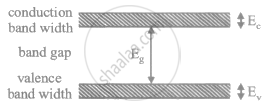Advertisements
Advertisements
प्रश्न
In a semiconductor,
(a) there are no free electrons at 0 K
(b) there are no free electrons at any temperature
(c) the number of free electrons increases with temperature
(d) the number of free electrons is less than that in a conductor.
उत्तर
(a) there are no free electrons at 0 K
(c) the number of free electrons increases with temperature
(d) the number of free electrons is less than that in a conductor
In semiconductors, the valence band is full at 0 K, but the conduction band is empty. So, no free electron is available for conduction at 0 K.
As the temperature increases, covalent bonds that provide free charge carriers for conduction in a semiconductor break.
As the conduction band in metals is already partially filled at 0 K, many free electrons below the Fermi level acquire energy from an external source or temperature, jump to the conduction band and start behaving like free electrons. Hence, metals contain more free electrons than semiconductors.
APPEARS IN
संबंधित प्रश्न
Draw energy band diagrams of an n-type and p-type semiconductor at temperature T > 0 K. Mark the donor and acceptor energy levels with their energies.
Distinguish between a conductor, a semiconductor and an insulator on the basis of energy band diagrams.
There are energy bands in a solid. Do we have really continuous energy variation in a band ro do we have very closely spaced but still discrete energy levels?
When an electron goes from the valence band to the conduction band in silicon, its energy is increased by 1.1 eV. The average energy exchanged in a thermal collision is of the order of kT which is only 0.026 eV at room temperature. How is a thermal collision able to take some to the electrons from the valence band to the conduction band?
What is the resistance of an intrinsic semiconductor at 0 K?
Let np and ne be the number of holes and conduction electrons in an intrinsic semiconductor.
When an impurity is doped into an intrinsic semiconductor, the conductivity of the semiconductor
In a transistor,
A semiconductor is doped with a donor impurity.
Calculate the number of states per cubic metre of sodium in 3s band. The density of sodium is 1013 kgm−3. How many of them are empty?
Let ΔE denote the energy gap between the valence band and the conduction band. The population of conduction electrons (and of the holes) is roughly proportional to e−ΔE/2kT. Find the ratio of the concentration of conduction electrons in diamond to the in silicon at room temperature 300 K. ΔE for silicon is 1.1 eV and for diamond is 6.1 eV. How many conduction electrons are likely to be in one cubic metre of diamond?
The conductivity of an intrinsic semiconductor depends on temperature as σ = σ0e−ΔE/2kT, where σ0 is a constant. Find the temperature at which the conductivity of an intrinsic germanium semiconductor will be double of its value at T = 300 K. Assume that the gap for germanium is 0.650 eV and remains constant as the temperature is increased.
(Use Planck constant h = 4.14 × 10-15 eV-s, Boltzmann constant k = 8·62 × 10-5 eV/K.)
If the lattice constant of this semiconductor is decreased, then which of the following is correct?

In a semiconductor, the forbidden energy gap between the valence, band and the conduction band is of the order of
Three photo diodes D1, D2 and D3 are made of semiconductors having band gaps of 2.5 eV, 2 eV and 3 eV, respectively. Which 0 ones will be able to detect light of wavelength 6000 Å?
Draw the energy band diagrams for conductors, semiconductors and insulators. Which band determines the electrical conductivity of a solid? How is the electrical conductivity of a semiconductor affected with rise in its temperature? Explain.
The energy required by an electron to jump the forbidden band in silicon at room temperature is about ______.
